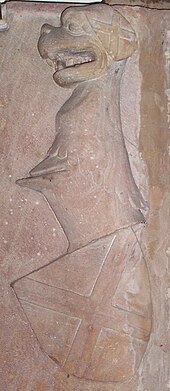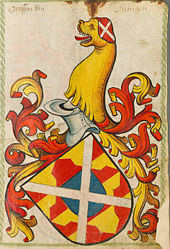Friedrich IV of Oettingen



Friedrich IV. Von Oettingen († September 19, 1415 in Eichstätt ) was Prince-Bishop of Eichstätt from 1383 to 1415.
origin
Friedrich IV. Von Oettingen came from the Swabian - Franconian dynasty of Oettingen . His name is also often combined with the title of the count. He was the son of Ludwig X. von Oettingen and Imagina, née von Schaumberg . Among his siblings, Louis XI. with the beard as court master of King Sigismund's importance. As early as 1237, Siegfried von Öttingen, as Bamberg's bishop, was a family member with high ecclesiastical dignity.
Life
He studied canon law and theology in Padua and Bologna . Before his appointment as Bishop of Eichstätt he was Eichstätter and Würzburg canon . After his election as Bishop of Eichstätt, he had to go to Pope Urban VI because of his young age of 23 . request dispensation, which he received. So he was enfeoffed with the regalia in February 1385 by King Wenceslaus .
According to the bishop's chronicle by Wilhelm Werner von Zimmer , written in 1550, Friedrich was a lover of beautiful horses (“special lust for beautiful horses”) and did not skimp on his court rulings; he is said to have been extremely frugal in the rest of the business.
At the beginning of his bishopric feuds, armed conflicts in the diocese and the robber baron regime . Above all the Upper Hochstift in the area around Herrieden suffered in the war of the princes against the League of Cities under the invasion of the troops of the League; Friedrich had moved from the camp of the Swabian League of Cities , which he had joined in 1383, to the camp of the princes. He took successful action against robber barons and nobles who violated episcopal rights. He waged feuds with the Lords of Absberg , Abensberg , Seinsheim , Seckendorff and with the Burgraves from Nuremberg . After he had defeated Wilhelm von Bebenburg in 1408 and the death sentence was carried out on 22 prisoners, no other Franconian nobleman invaded his bishopric.
Friedrich also fought the sectarians , especially the Waldensians . Ten of them were executed in Wemding in 1394 after a trial brought by the bishop .
His finance and acquisition policy was quite successful, as the Gundekarianum reports. So he bought Brunneck Castle in Anlautertal , the Burghut in Sandsee , Thannhausen Castle , some parts of Wahrberg Castle and goods in many places. He spent 18,000 guilders on his construction work. His Baueifer was primarily the fortifications that made it create new or improve, for example, at the Eichstätt Willibaldsburg at Schloss Reichenau , Castle Hirschberg , the castle Mörnsheim , the castle Nassenfels , the castle Arberg and the castle Kipfenberg . He also continued the work of his predecessor on the nave of the Eichstätter cathedral, so that it could be inaugurated on October 13, 1396. In 1411 he had an iron hammer set up in Obereichstätt .
Friedrich tried to reform his clergy . In addition to strict guidance, he also took care of the acquisition of liturgical books. Every year he held a diocesan synod. In Spalt he reformed the canons' monastery. He promoted the veneration of the Eucharistic sacrament and introduced the Corpus Christi procession in the city of Eichstätt . Every year he carried the monstrance he donated through his royal seat.
He died at the age of 55 and was buried in the Willibald Choir of Eichstätter Cathedral ; there he had St. Barbara , whom he greatly admired, donated an altar.
Elisabeth von Oettingen († July 9, 1406), the sister of the bishop, was a lady-in-waiting of the Palatinate Elector and German King Ruprecht III. Her grave with a magnificent coat of arms epitaph has been preserved in the collegiate church (Neustadt an der Weinstrasse) .
literature
- Klaus Kreitmeir: The bishops of Eichstätt . Eichstätt 1992, publisher of the church newspaper. Pp. 58-60
- Alfred Wendehorst : The diocese of Eichstätt. Volume 1: The row of bishops until 1535 . Series: Germania Sacra - New Episode 45 . Berlin 2006. ISBN 978-3-11-018971-1 . Pp. 179-188.
- Klaus Kreitmeir: He taught robber barons to fear. In: Eichstätter Kirchenzeitung of November 23, 2008, p. 30
Individual evidence
- ↑ compare list of noble families in Franconia
- ↑ a b Kreitmeir (1992), p. 58
- ↑ a b c d Kreitmeir (2008), p. 30
- ↑ a b Kreitmeir (1992), p. 59
- ↑ http://www.eichstaett.de/
- ↑ Wendehorst, p. 184
- ↑ Kreitmeir (1992), p. 60
| predecessor | Office | successor |
|---|---|---|
| Raban Truchseß from Wilburgstetten |
Bishop of Eichstätt 1383–1415 |
Johann II of Heideck |
| personal data | |
|---|---|
| SURNAME | Friedrich IV of Oettingen |
| BRIEF DESCRIPTION | Prince-Bishop of Eichstätt |
| DATE OF BIRTH | 14th Century |
| DATE OF DEATH | September 19, 1415 |
| Place of death | Eichstatt |

